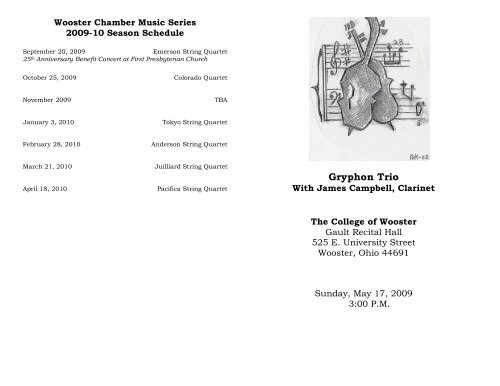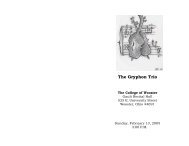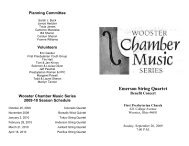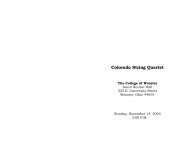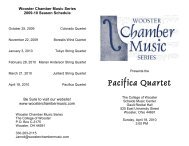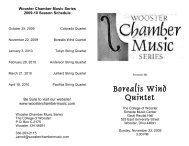Gryphon Trio - Wooster Chamber Music Series
Gryphon Trio - Wooster Chamber Music Series
Gryphon Trio - Wooster Chamber Music Series
Create successful ePaper yourself
Turn your PDF publications into a flip-book with our unique Google optimized e-Paper software.
<strong>Wooster</strong> <strong>Chamber</strong> <strong>Music</strong> <strong>Series</strong><br />
2009-10 Season Schedule<br />
September 20, 2009<br />
Emerson String Quartet<br />
25 th Anniversary Benefit Concert at First Presbyterian Church<br />
October 25, 2009<br />
Colorado Quartet<br />
November 2009<br />
TBA<br />
January 3, 2010<br />
Tokyo String Quartet<br />
February 28, 2010<br />
Anderson String Quartet<br />
March 21, 2010<br />
April 18, 2010<br />
Juilliard String Quartet<br />
Pacifica String Quartet<br />
<strong>Gryphon</strong> <strong>Trio</strong><br />
With James Campbell, Clarinet<br />
The College of <strong>Wooster</strong><br />
Gault Recital Hall<br />
525 E. University Street<br />
<strong>Wooster</strong>, Ohio 44691<br />
Sunday, May 17, 2009<br />
3:00 P.M.
harmony lost in the trees. Transposing that to a religious level, you have<br />
the harmonious silence of heaven. The piano plays a rhythmic ostinato<br />
based on three Hindu rhythms; the clarinet spins out a bird song.<br />
II. Vocalise, for the Angel Announcing the End of Time: The first and<br />
third parts evoke the power of this strong angel, crowned with a rainbow<br />
and clothed in clouds, one foot on the sea and the other on land. The<br />
central section deals with the impalpable harmonies of heaven, the piano<br />
playing soft cascades of chords: blue and mauve, gold and green, redviolet,<br />
blue-orange; all of this dominated by steel-grey. These chords<br />
surround the plainchant-like melody of the violin and cello.<br />
III. The Abyss of the Birds: Clarinet solo. The abyss is time, in its<br />
sorrows and lassitudes. The birds offer a contrast, symbolizing our<br />
yearning for light, stars, rainbows and jubilant voices. The piece begins<br />
in sadness. Notice the long tones: pianissimo, crescendo molto to the<br />
most atrocious fortissimo. The bird-songs are written in the gay and<br />
fanciful style of the blackbird. The return to desolation is manifested in<br />
the dark timbre of the clarinet's lower register.<br />
IV. Interlude: Scherzo. Of a more outgoing character than the other<br />
movements, but related to them by various melodic references.<br />
V. Praise to the Eternity of Jesus: Jesus represents, in this context,<br />
the word of God. One long, extremely slow phrase by the cello glorifies<br />
with tenderness and reverence the eternity of this powerful and gentle<br />
Word. Majestically the melody unfolds like a distant memory, tender and<br />
all encompassing. "In the beginning was the Word, and the Word was<br />
with God, and the Word was God."<br />
VI. Dance of Wrath, for the Seven Trumpets: Rhythmically the most<br />
idiosyncratic movement of the set. The four instruments in unison give<br />
the effect of gongs and trumpets (the first six trumpets of the Apocalypse<br />
attend various catastrophes; the trumpet of the seventh angel announces<br />
the consummation of the mystery of God). <strong>Music</strong> of stone, formidable<br />
sonority; movement as irresistible as steel, as huge blocks of livid fury or<br />
ice-like frenzy. Listen particularly, toward the end of the piece, to the<br />
terrifying fortissimo of the theme in augmentation and with change of<br />
register of its different notes.<br />
VII. Tangle of Rainbows, for the Angel Announcing the End of Time:<br />
This movement is dedicated to the angel, and even more so, to the<br />
rainbow covering him (a rainbow symbolizing peace, wisdom, and all<br />
luminous and resonant vibration). In my coloured dreams I hear and see<br />
ordered melodies and chords, familiar hues and forms; then, following<br />
this transitory stage I pass into the unreal and submit ecstatically to a<br />
vortex, a dizzying interpenetration of superhuman sounds and colours.<br />
These fiery swords, these rivers of blue-orange lava, these sudden stars:<br />
Behold the cluster, behold the rainbows!<br />
VIII. In Praise of the Immortality of Jesus: Abroad violin solo,<br />
balancing the cello solo of the fifth movement. Why this second tribute?<br />
It addresses more specifically the second aspect of Jesus –the man, the<br />
Word made flesh, raised from the dead and immortalized to make His life<br />
known to us. This movement is pure love. It ascends gradually toward an<br />
intense peak, the ascension of man towards God, of the Son of God<br />
toward his Father, of the creature become divine towards paradise.<br />
--- Brian Biddle<br />
<strong>Gryphon</strong> <strong>Trio</strong><br />
With James Campbell, Clarinet<br />
Annalee Patipatanakoon, violin; Roman Borys, cellist; Jamie Parker, piano<br />
The <strong>Gryphon</strong> <strong>Trio</strong> is one of North America’s finest chamber ensembles.<br />
Since their founding in 1993, they have appeared throughout Canada,<br />
the United States, and Europe, delighting critics and audiences with<br />
exhilarating, and sometimes unusual, performances.<br />
The <strong>Gryphon</strong> <strong>Trio</strong> is highly versatile, both in repertoire and in the<br />
venues where they have played, enabling them to reach new and younger<br />
audiences. In addition to works by such established composers as<br />
Haydn, Mozart, Beethoven, Schubert, Mendelssohn, Dvorak, and<br />
Shostakovich, the group has actively expanded the piano trio repertoire<br />
with pieces by numerous contemporary composers. They have<br />
commissioned and premiered more than 50 works by composers who<br />
include Christos Hatzis, Chan Ka-Nin, Gary Kulesha, and others. They<br />
have expanded the reach of chamber music in varied collaborations,<br />
such as those with clarinetist James Campbell (who appears with them<br />
today), actor Colin Fox, choreographer David Earle, and many wellknown<br />
jazz artists at Toronto’s Lula Lounge. Their Constantinople is a<br />
groundbreaking multidisciplinary production, composed by Hatzis, which<br />
integrates instrumental, visual, theatrical, and vocal art into a socially<br />
poignant exploration of the human spirit.<br />
The most recent of the <strong>Gryphon</strong>’s ten recordings is Tango Nuevo,<br />
with music by Astor Piazzolla and Hilario Duran. The group won a<br />
coveted Juno Award (in Canada) in 2004 for their Canadian Premieres,<br />
featuring the works of leading Canadian composers. The <strong>Gryphon</strong> <strong>Trio</strong><br />
are Artists-in-Residence at the University of Toronto. In addition to<br />
teaching and performing at the University, they give frequent master<br />
classes and presentations at schools and universities across the<br />
continent, and have presented lecture-demonstrations with composer<br />
Gary Kulesha and music commentator Rob Kapilow, through <strong>Music</strong><br />
TORONTO. They are Artistic Programming Directors of the Ottawa<br />
International <strong>Chamber</strong> <strong>Music</strong> Festival, having already established<br />
themselves as beloved performers at this and many other chamber music<br />
festivals.<br />
Clarinetist James Campbell has performed in major concert halls<br />
throughout the world. He has appeared with over fifty orchestras,<br />
including the London Symphony, the Russian Philharmonic, the<br />
Edmonton Symphony Orchestra, and the Boston Pops. He has<br />
collaborated with more than thirty renowned string quartets, such as the<br />
Amadeus, the Guarneri, the Vermeer, and the Allegri String Quartets.<br />
Mr. Campbell has performed with musical luminaries that include both<br />
Aaron Copland and Glenn Gould. He has recorded extensively, with over<br />
forty recordings so far, including his Juno Award-winning Stolen Gems.<br />
Other noted releases include the Brahms Clarinet Quintet, with the<br />
Allegri Quartet, which was voted “Top Choice” by BBC Radio 3; and the<br />
Sony Classical re-release of Debussy’s Premier Rhapsody with pianist<br />
Glenn Gould. (Those familiar with the Internet can visit YouTube.com, do<br />
a quick search, and view delightful footage from the Campbell/Gould<br />
Debussy performance.) Since 1984, Mr. Campbell has been Artistic
Director of Festival of the Sound, an annual summer chamber music<br />
festival in Parry Sound, Ontario. During the academic year, he resides in<br />
Bloomington, Indiana, where he has been Professor of <strong>Music</strong> at the<br />
prestigious <strong>Music</strong> School of Indiana University since 1989.<br />
PROGRAM NOTES<br />
--- Sarah J. Buck<br />
Franz Joseph Haydn (1732-1809)<br />
<strong>Trio</strong> in A Major, Hob. XV:18 (1793)<br />
Haydn's A Major trio dates from the composer's extremely successful<br />
five-year stay in London. <strong>Trio</strong>s 18-20 were published concurrently, and<br />
all were dedicated to Maria Therese Esterházy, the widow of Haydn's<br />
former employer Prince Anton. The works from this period marked for<br />
Haydn a return to piano music after a nearly four-year hiatus.<br />
Piano trios in the time of Haydn are more accurately viewed as<br />
accompanied piano sonatas than the more modern dialogue between<br />
three equal instruments; many of Haydn's trios were published as<br />
“Sonatas for Piano Accompanied by Violin and Cello.” The cello serves as<br />
reinforcement for the left-hand piano material much of the time. The<br />
violin, while still subservient to the piano, does have some moments to<br />
shine, embellishing the melodic framework set out by the piano. The<br />
Andante second movement gives the violin and cello their own lyrical<br />
moments, as in the opening passage where the piano passes the second<br />
phrase of the melody to the violin. The trio is a delightful, wellconstructed<br />
example of late eighteenth-century chamber music<br />
composition.<br />
Leonard Bernstein (1918-1990)<br />
Sonata for Clarinet and Piano (1941-42)<br />
“I've always loved the Clarinet Sonata, particularly because it was my<br />
first published piece,” Bernstein remarked later in life. “I remember how<br />
proud I was of it and, for that matter, I still am – in spite of a certain<br />
student element in the work.” Bernstein's first mature work arrived at a<br />
time when the young musician was deciding whether to pursue a career<br />
in composition or conducting. Bernstein's mentors in both fields (Aaron<br />
Copland and Serge Koussevitsky) were among the most well-regarded of<br />
their generation; in the summers of 1940 and 1941 Bernstein benefited<br />
from the shared expertise of these and many others at Koussevitsky's<br />
summer festivals at Tanglewood. Sketches for the Clarinet Sonata were<br />
begun at the close of the 1941 Tanglewood season and the work was<br />
complete by the following February.<br />
The sonata is organized into two concise movements. The strongly<br />
motivic and lyrical opening of the Grazioso betrays the clear influence of<br />
Paul Hindemith, who was in residence at Tanglewood at 1941 – Copland<br />
went so far as to call the piece “full of Hindemith” following the work's<br />
1943 premiere. After a fairly academic course of statement, development,<br />
and restatement, the first glimpses of Bernstein's mature voice emerge in<br />
a wistful extended coda. The second movement returns to Hindemith<br />
with its opening Andantino featuring a reflective clarinet melody.<br />
Suddenly the outgoing Vivace emerges, fraught with lively syncopation<br />
and irregular meter characteristic of Bernstein's later dance music. The<br />
slow, introspective music returns almost too soon. It is, however, merely<br />
a temporary diversion, as the fast material happily returns, pushed<br />
forward this time with an imperative ostinato from the piano. Mixed<br />
meters and a journey to the top of the clarinet's register provide a joyful<br />
conclusion to this intriguing look into the formative years of a musical<br />
genius.<br />
Olivier Messiaen (1908-1992)<br />
Quatour pour la fin du temps (Quartet for the End of Time) (1940-41)<br />
One of the most significant chamber music works of the twentieth<br />
century arose from a series of chance encounters in perhaps the most<br />
unlikely of settings: the prison camps of World War II. At the outbreak of<br />
the war, Messiaen (already an accomplished composer) was called up by<br />
the French army; in May 1940 his unit was captured by the Germans at<br />
Verdun during the blitzkrieg. Interned at Stalag VIII-A in Gŏrlitz,<br />
Messiaen took comfort in the company of several fellow musicians in his<br />
unit, clarinetist Henri Akoka and cellist Etienne Pasquier. Violinist Jean<br />
Le Boulaire soon joined the group at the P.O.W. camp. Pasquier's<br />
assignment as cook ensured the quartet remained well fed, and selling<br />
surplus food allowed him to buy a modest used cello to pass the time.<br />
Akoka and Boulaire managed to keep their instruments with them in the<br />
camp. When Messiaen discovered a humble piano in a makeshift church<br />
on the prison grounds, the stage was set for the creation of the quartet.<br />
Composition provided a welcome escape from reality for Messiaen,<br />
and the piece emerged quickly. The group premiered the work for an<br />
audience of several thousand prisoners and prison guards, including the<br />
Stalag's Kommandant. “Never was I listened to with such rapt attention<br />
and comprehension,” Messiaen later noted. The premiere earned<br />
Messiaen and his comrades respect and admiration from prisoners and<br />
guards alike. Soon after, prison staff erroneously reclassified the quartet<br />
as noncombatant musicians, causing the German bureaucracy to order<br />
their immediate release. They were freed by May 1941.<br />
In a preface to the original score, Messiaen explained his inspiration<br />
for the work and described each of the eight movements. A quotation<br />
from the Book of Revelation forms the spiritual underpinnings of the<br />
work:<br />
And I saw another mighty angel come down from heaven,<br />
clothed with a cloud: and a rainbow was upon his head, and<br />
his face was as it were the sun, and his feet as pillars of fire ...<br />
and he set his right foot upon the sea, and his left foot on the<br />
earth ... And the angel which I saw stand upon the sea and<br />
upon the earth lifted up his hand to heaven, and sware by him<br />
that liveth for ever and ever ... that there should be time no<br />
longer: But in the days of the voice of the seventh angel, when<br />
he shall begin to sound, the mystery of God should be finished<br />
.... (Rev. 10:1-2, 5-7)<br />
Messiaen made the following comments for each movement:<br />
I. Crystal Liturgy: Around five o'clock in the morning, a lone bird<br />
improvises, surrounded by fine fragments of sound, by a halo of
<strong>Gryphon</strong> <strong>Trio</strong><br />
With James Campbell, Clarinet<br />
Annalee Patipatanakoon, violin; Roman Borys, cellist; Jamie Parker, piano<br />
PROGRAM<br />
Piano <strong>Trio</strong> in A Major, Hob XV:18 (1793)<br />
Franz Joseph Haydn<br />
I. Allegro moderato (1732-1809)<br />
II. Andante<br />
III. Allegro<br />
Sonata for Clarinet and Piano (1941-42)<br />
Leonard Bernstein<br />
I. Grazioso (1918-1990)<br />
II. Andantino<br />
INTERMISSION<br />
Quatour pour la fin du temps (Quartet for the End of Time) Olivier Messiaen<br />
(1940-41) (1908-1992)<br />
I. Crystal Liturgy<br />
II. Vocalize, for the Angel announces the End of Time<br />
III. Abyss of the Birds<br />
IV. Interlude<br />
V. Praise to the Eternity of Jesus<br />
VI. Dance of Wrath, for the Seven Trumpets<br />
VII. Tangle of Rainbows, for the Angel Announcing the End of Time:<br />
VIII. In Praise of the Immortality of Jesus<br />
Presented with support of<br />
A special thanks to Mrs. Joseph Fishelson and<br />
Dr. Jay Klemme for their support<br />
Bill and Marilyn Blanchard<br />
Mary Grace Engisch<br />
Carlye and Frank Cebul<br />
H. Alberta Colclaser<br />
Grant and Peg Cornwell<br />
Marian Taylor Cropp<br />
Com-Patt-ibles Floral Elegance<br />
William Dameron<br />
Mildred Froelich<br />
Steve and Liz Glick<br />
Catherine and Tom Graves<br />
Elinor Hancock<br />
UNDERWRITER<br />
Sarah Jane Buck and Nick Amster Fishelson<br />
Mr and Mrs Stanley C. Gault<br />
*Deborah P. Hilty<br />
Jay Klemme and Anne Wilson<br />
Lois G. McCall<br />
The Donald and Alice Noble Foundation<br />
Cyril and Amelia Ofori<br />
Viola Startzman Robertson<br />
Ken and Jill Shafer<br />
Tim and Jenny Smucker<br />
Yvonne C. Williams<br />
*in memory<br />
BENEFACTOR<br />
David and Carol Briggs<br />
Dorothy Carlisle<br />
Ed and Mary Eberhart<br />
Louise E. Hamel<br />
Terry Wagner Ling<br />
Clara Louise Patton<br />
Margaret and David Powell<br />
Bill and Carolyn Sheron<br />
PATRON<br />
Carolyn Hostetler<br />
Peter and Tricia James<br />
Lyn Loveless<br />
Julie A Mennes<br />
Sara L. Patton<br />
Kenneth and Louise Plusquellec<br />
Erwin and Susan Riedner<br />
Ed Schrader and Dan Rider<br />
Steve and Cheryl Shapiro<br />
Mary Alice Streeter<br />
Marilyn Tanner<br />
Kathy and Harry Zink<br />
Martha E. Banks<br />
Janelle and Jim Collier<br />
Mary Finkbeiner<br />
Alice and Larry Gabriel<br />
Lucille L. Hastings<br />
Frank and Jean Knorr<br />
Elena Sokol and Yuri Popov<br />
Don and Linda Sommer<br />
SUBSCRIBER<br />
Derek Somogy<br />
Thomas W. Tappan<br />
Grace M. Tompos<br />
Peggy and Charles Ulrich<br />
Carol and Ken Vagnini<br />
Mina and Don Van Cleef<br />
Catherine D. Wiandt<br />
Carol Rueger and David Wiesenberg


